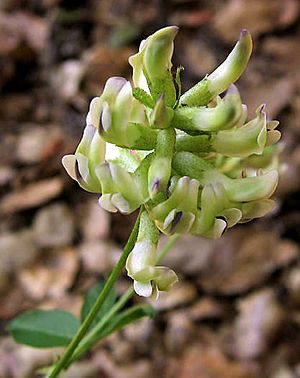Forest scurfpea facts for kids
Quick facts for kids Forest scurfpea |
|
|---|---|
 |
|
| Scientific classification | |
| Kingdom: | |
| (unranked): | |
| (unranked): | |
| (unranked): | |
| Order: | |
| Family: | |
| Subfamily: | |
| Genus: |
Rupertia
|
| Species: |
R. physodes
|
| Binomial name | |
| Rupertia physodes (Hook.) J.W.Grimes
|
|
| Synonyms | |
|
Psoralea physodes |
|
Rupertia physodes, also known as forest scurfpea or California tea, is a type of legume plant. Legumes are a family of plants that include peas, beans, and lentils. This plant grows naturally along the west coast of California and in the coastal mountains. You can also find it further north in the Cascade Range, reaching into Idaho and British Columbia.
Contents
Description
Rupertia physodes is a plant that grows low to the ground. It often forms a thick cover, like a carpet. It has strong, woody roots that go deep into the soil. This plant likes to grow in dry areas, such as the edges of forests and open grasslands. It blooms in late spring and summer. This is a time when not many other plants are flowering, so it provides food for insects.
Its Leaves
The leaves of Rupertia physodes are made up of three smaller leaflets. These leaflets are dark green and shaped like a tear. They are mostly smooth, but they might have a few hairs along their veins.
Its Flowers
The flowers grow close together on a stem about 5 centimeters (2 inches) long. Each stem can have between 25 and 40 flowers. The individual flowers look like small peas. They are white or cream-colored when they first open. They might have a hint of green or purple. As they get older, they change to a rusty brown color.
A special thing about this plant is what happens after the flower falls off. The part of the flower called the calyx keeps growing. It becomes much bigger than the seed pod that is forming. It creates a large, cone-shaped collar around the single seed pod.
Its Seeds
When the plant's seeds are ready, the pod turns grayish. It is soft and can be easily rubbed off. Inside, there is one shiny black seed. This seed is about 5 millimeters long and shaped like a kidney bean. The mature parts of the plant have a light, resin-like smell. Some people say it smells a bit like hops.

